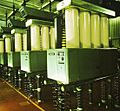Mercury-arc rectifier facts for kids
A mercury-arc rectifier was a special device. It changed alternating current (AC) into direct current (DC). Think of it like a one-way street for electricity. It used a pool of liquid mercury to do this job. These rectifiers were very strong and could handle a lot of electrical power.
Contents
What is a Mercury-Arc Rectifier?
A rectifier is a device that changes the type of electricity. Most homes use AC power, which changes direction many times a second. But some devices need DC power, which flows in only one direction. A mercury-arc rectifier was built to make this change. It was a large glass or metal container. Inside, it had a small pool of liquid mercury. This mercury acted as a key part of the electrical circuit.
How Did It Work?
The mercury-arc rectifier worked using an electric arc. This arc formed between the liquid mercury and other parts inside the container. When the AC power was applied, the arc would only allow current to flow in one direction. This changed the AC into DC. It was a very effective way to handle high amounts of power.
History and Uses
The mercury-arc rectifier was invented in 1902. A scientist named Peter Cooper Hewitt created it. For many years, it was the main way to change large amounts of AC power to DC.
Where Were They Used?
These rectifiers were very important for many industries. They powered large electric motors in factories. They also supplied electricity for electric trains, trams, and electric locomotives. Some radio transmitters used them too. They were even used in early systems for sending high-voltage direct current (HVDC) power over long distances.
Why Were They Replaced?
Mercury-arc rectifiers were widely used until the 1970s. Then, new technology came along. This new technology was called "solid-state electronics." Solid-state rectifiers were smaller, more efficient, and didn't use liquid mercury. Because of these benefits, solid-state devices replaced the mercury-arc rectifier. Today, you won't find many mercury-arc rectifiers still in use. They are mostly seen in museums or historical displays.
Images for kids
-
Mercury rectifier on display in the Beromünster AM transmitter in Switzerland, before being decommissioned. Three-phase full-wave rectifier with six anodes.
-
Mercury arc valves of ASEA design, with four anode columns in parallel, in the HVDC Inter-Island scheme in New Zealand.
-
A 150-kilovolt, 1800 amp mercury-arc valve at Manitoba Hydro's Radisson converter station, August 2003
-
An experimental mercury arc amplifier for use on long-distance telephone circuits. It was never commercially used after the development of the audion tube.








